Coordinating Fast Paced Urban Construction
Fast-paced construction within a dense urban environment like New York City has several distinctive rationales, approaches, constraints, and requirements that necessitate careful coordination. The fundamental principle that drives the need for speed in construction is economic. The sooner a new building is completed and put into operation, the lower are the carried financing costs and the sooner the project can recapture generated revenue streams. There are numerous approaches and structural systems that can speed up the construction process. This article focuses on characteristics of flat plate concrete systems which, when floor plates are repetitious and identical, can achieve fast superstructure builds by using a 2-day concrete placement cycle. However, in tight urban locations, spatial constraints for staging, installation, material, and labor, as well as complexity of architectural/design coordination, can potentially interrupt the cycle and cause delays. Instant communication and in-the-field coordination are keys to maintaining the fast paced schedule and to minimizing mistakes. The structural engineer needs to be fully immersed in the day-to-day construction process to ensure successful and timely completion of the project.
Three projects in New York City are presented to illustrate coordination issues that are particular to this type of construction: Avalon West Chelsea, 41-42 24th Street (aka “QLIC”), and 150 Charles Street. These developments are primarily multi-family residential, but also feature street-level retail, at- and below-grade parking, and amenity features at upper levels including planted green roofs and terraces. Both Avalon West Chelsea and QLIC are rental buildings that required high-speed construction. In contrast, 150 Charles Street is a luxury condominium development.
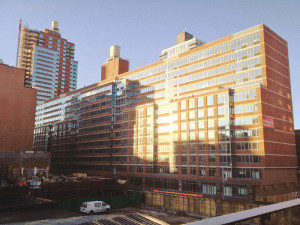
Figure 1. Avalon West Chelsea. View from High Line Park.
Avalon West Chelsea
Avalon West Chelsea is a recently completed 588,000 square-foot “L-shaped” building located in the prime Chelsea Arts District of Manhattan (Figure 1). Programmatically, this building consists of two distinct components: a 31-story tower featuring 309 luxury apartments, and a 14-story mid-rise that extends from the tower at the west to the elevated rail structure, now known as High Line Park, at the east, housing 405 units geared toward a younger demographic. The LEED Silver certified property also includes 142 affordable housing units, roof-top terraces, green roofs, rear yards, a fitness center, lounge areas, a 140-car parking garage, and retail space at street level.
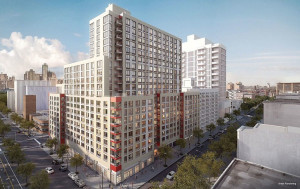
Figure 2. QLIC – architect’s rendering.
QLIC
QLIC, a 400,000 square-foot development at Queens Plaza North in Long Island City, is nearly complete (Figure 2). The 21-story tower holds 421 rental units, double-height retail at grade and parking for 120 cars below grade. The building’s 28,000 square feet of amenity space includes a rooftop pool, cabanas, a roof deck with an open-air theater and barbecue, a landscaped courtyard with a fire pit, media lounge, game room, fitness center, and other amenities on an accessible terrace.
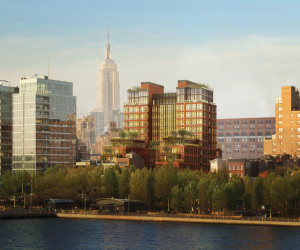
Figure 3. 150 Charles Street – architect’s rendering.
150 Charles Street
This 300,000 square-foot, 16-story luxury residential development in Manhattan’s West Village consists of 98 condominium units (Figure 3). The project incorporates the façade structure of an existing 4-story warehouse for the lower podium floors. Above, two corner towers flank a mid-block volume and each floor steps back, forming a cascade of terraces toward the Hudson River. The superstructure accommodates high gravity loads due to precast façade assemblies as well as 40,000 square feet of landscaped courtyards, green-roofs and planted terraces with up to five feet of soil cover. The building’s total landscaped area is equivalent to the combined areas of four small neighboring parks.
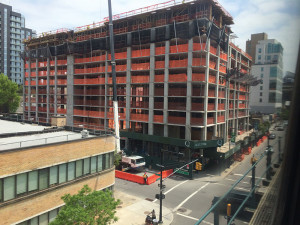
Figure 4. Flat plate concrete construction at QLIC.
Structural Systems
The structural systems of the three buildings consist of reinforced cast-in-place concrete flat plates, which is the most common slab structural system for high-rise residential construction in New York City (Figure 4). Compared to other structural systems, flat-plate construction maximizes usable floor-to-ceiling space (no beams or suspended ceilings) and also provides flexibility in the architectural layout of interiors since columns are not constrained to gridlines. This type of construction affords both lower costs and, depending on the uniformity of design, faster erection. Concrete construction is also inherently fireproof and, with sufficient slab thickness, is minimally susceptible to vibration and noise transmission between floors.
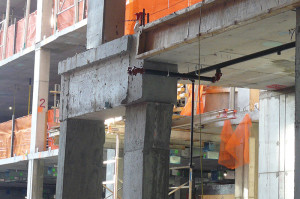
Figure 5. Column transfer at 150 Charles. This transfer occurs at the slab edge and uses a concrete beam segment. Transfers at slab interior employ beams or thicker slab sections.
At Avalon West Chelsea, floor slabs are supported by almost 200 columns that range from one story to thirty-one stories, and seven shear wall configurations around two vertical cores. QLIC employs 120 columns and four cores. Despite its smaller size, 150 Charles Street has over 300 columns, though few of these extend the full height of the building. Columns are transferred from level to level, because each floor has a distinct architectural layout (Figure 5, page 54). For contrast: 1) QLIC included 10 column sizes and 4 transfers, 2) Avalon West Chelsea had 14 column sizes and approximately 20 transfers, primarily at the 13th floor connection between the tower and the mid-rise, and 3) 150 Charles included 41 various column sizes and 250 transfers, whereby columns substantially changed location, size/shape, or orientation between floors. Shear walls are located around building cores that house elevator shafts and egress stairs to provide a structural and fireproof enclosure of these spaces and to minimize the architectural impact of the walls. The 8-inch slabs used at each of these buildings accommodate multiple in-slab mechanical and plumbing services, as well as electrical conduits.
The smaller-footprint repetitious upper floors of Avalon West Chelsea and QLIC were erected using one concrete pour on a two-day cycle (see below for explanation), whereas the larger lower levels required several pours. At 150 Charles, due to the irregular and constantly changing floor layouts, slab elevation steps, and the larger quantity of column sizes (requiring differently sized formwork), concrete placement took 16 days on average per floor. At QLIC, the locations of construction joints between the two or three pours at the 27,000 square-foot horseshoe-shaped lower eight floors were assessed and determined in the field by the inspector-engineer. In-house Special Inspections therefore served to expedite this coordination in the field. At Avalon West Chelsea, however, the 575-foot-long floor slabs of the lower 14 floors demanded an advanced construction sequence analysis to understand changes in temperature and shrinkage of concrete. The structural design thus enabled a four-part pour sequence without the need for any expansion joints. All three projects incorporated crack-control reinforcing at column exteriors, shear wall corners, and re-entrant corners.
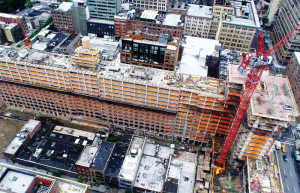
Figure 6. Avalon West Chelsea. Tower (at right) is on a 2-day cycle, with staging on mid-rise roof deck.
2-Day Cycle
The tower portions of Avalon West Chelsea (above the 14th floor) and QLIC (above the 16th floor) were built using a 2-day cycle whereby an entire floor slab is poured every two days (Figure 6). The maximum feasible floor size that can achieve a 2-day cycle is around 20,000 square feet, with floor plates around 65 feet wide. This dimension is typical of multifamily rental buildings organized around double-loaded corridors, and was the case for both buildings. Only a skilled labor force, experienced with this method of construction, can execute the cycle because it requires a specific sequence of tasks before crews can proceed to subsequent floors. These tasks include installation of: deck slab formwork, bottom mats, MEP duct/conduit/pipe & blockouts, top mats, concrete for deck slab, column/shear wall formwork, reinforcing steel, and concrete for columns/shear walls. Therefore, a setback of any single step of the process can potentially “domino” into a delay of an entire work day.
With the advent of computer aided analysis and design, buildings are more complex, less repetitive, and less conservative than they were in the 1950s, when this technique was developed. High-performance buildings today also hold many more systems and services, so there are more trades and more congestion on the construction site. As a result, buildings with a 2-day cycle today are more challenging than they were half a century ago.
Coordination
During superstructure erection of high-rise buildings, materials and equipment must be lifted to the top level using a tower crane, which all trades share. If a delay in delivery or staging prevents a component’s lift, placement crews must improvise using materials that are available on the deck, rather than wait for subsequent lifts. The engineer must be available to assess if each ad hoc substitution is structurally acceptable. Moreover, at dense urban construction sites that have limited space for staging and storage, contractors may request temporary slab openings in order to reposition materials and equipment, or achieve clearance for installation. These logistics are not included on construction documents and are typically decided in the field. In the event that the designed slab reinforcement gets displaced as a result, the structural engineer is on-hand to coordinate its relocation.
Coordination of mechanical, electrical and plumbing (MEP) trades typically occurs during shop drawing review, and layouts of these systems remain schematic until finalization of construction documents. MEP subcontractors often respond to field conditions by proposing amendments to sizes or locations of slab penetrations, which may impact the structural design. Such substitutions require the structural engineer’s review to confirm that the integrity of the slab is not compromised.
Foundations
The foundation of QLIC is a combination of spread footings and a 3-foot mat foundation over rocky geology. The columns and shear walls at Avalon West Chelsea are supported by more than 1,000 piles within a 67,000 square-foot site containing varying rock and soil conditions. Here, the underlying rock stratum was found to be so shallow in about one-third of the site that the piles were too short to achieve substantial lateral resistance capacity. However, the remaining piles were able to provide sufficient lateral resistance to eliminate the need for footings or additional foundation elements. A foundation slab ties all the piles together. As the floor slabs are designed without an expansion joint, the structure engages all the piles jointly. The stiffness of the slab without expansion joints enables the 14-story mid-rise structure to laterally support the tower.
Envelope
Avalon West Chelsea employs a standard masonry/curtain wall façade. The building envelope system of QLIC, however, is comprised of prefabricated metal-stud-reinforced panels with thin brick veneer. These components were assembled on Long Island along with windows fabricated in Buffalo, and then shipped to the construction site in Queens. These panels with pre-installed windows were lifted and attached to the building using a crane. While the price of this system is comparable to traditional masonry façade systems, utilizing prefabricated panels saved roughly 20% of the time required to enclose the building.
The combination of using the pre-assembled façade panels and just-in-time shipping (a delivery method whereby material arrives to the site at the time it is to be installed) resulted in multiple benefits for the design and construction team. By assembling the panels in the shop, the working conditions and consistent temperatures allowed for higher quality water- and air-tightness, improving the energy efficiency of the building. Just-in-time delivery allowed the Contractor to minimize staging and storage space while efficiently enclosing the building.
While 150 Charles also used pre-fabricated panel components (in this case pre-cast concrete with brick exterior), the entire building featured additional façade systems including masonry cavity walls, curtain walls, window walls, stone cladding & storefront assemblies. In most locations, the 13-inch precast panels are at least as thick as the building frame to which they are attached (Figure 7).
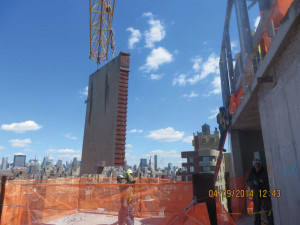
Figure 7. 13-inch precast façade panel at 150 Charles Street.
Uniformity
Uniformity of design and repetition of structural elements enables efficiency of construction, which in turn results in economies of scale. This approach allows installation crews to maintain consistent work processes and reuse formwork, rather than needing to adjust for each individual location. This speeds-up erection. At Avalon West Chelsea and QLIC, approximately 80% of the columns have the same cross section and reinforcing. At Avalon West Chelsea, 80% of pile caps are also typical.
The varying areas of the floor plates and architectural amenity features at 150 Charles required a different interior layout for every floor, as well as numerous slab elevation changes at each level. This provided opportunities for innovative solutions to structural challenges associated with shifting and rotating columns between the floors through slab transfers. While the structural design responds to the architectural requirements to achieve real estate marketing objectives, such a design is not conducive to sustaining a 2-day cycle. The complexity and variety of floor layouts result in lathers relocating their staging at each level. The work space is further congested by MEP trades that also deal with offsetting mechanical shafts and plumbing risers at each floor.
Team Interconnectedness
The structural engineer’s continuous presence in the field allows for quick responses to coordination issues. Since Gilsanz Murray Steficek (GMS), the project’s Structural Engineer, also served as special inspector of concrete and steel at each project, the engineer-inspector was often on-site. A direct line of communication between the construction team and the design team allowed challenges to be immediately resolved with the contractor, trades and other design team members, as needed.
Having both structural and building envelope teams in-house allowed communication of structural requirements internally, without the need for time-consuming Request For Information (RFI) processes through the architect, thus enabling speedy communication and coordination of interacting structural and envelope systems. Another aspect that facilitated coordination at QLIC was the use of Building Information Modeling (BIM), whereby all trades (structural, mechanical, electrical, etc.) could be coordinated within a single digital 3D model during design development and pre-construction. Few unanticipated conditions remained in the design by the time the first shovel hit the ground.
Economics
The speed of construction translates directly to cost of the project. New York City construction projects with the scale and complexity of Avalon West Chelsea typically employ approximately 150 union workers on a given day of superstructure erection. According to local prevailing wages, this project would incur a cost of over $100,000 for a delay of a single day for labor alone. This does not include other costs associated with remobilization or equipment rentals. At the same time, the owner continues to maintain high-interest construction loans and his receipt of operating revenues is also delayed. As a result, field changes after concrete placement, such as demolition/removal/re-placement of concrete, or fiber-reinforced polymer applications for topical reinforcement or modification/repairs, while expensive, tend to be more economical to both contractor and developer as opposed to stalling the construction cycle for design coordination.
The impact of construction speed upon a project’s overall economics, however, depends largely on the type of asset that is being developed. Avalon West Chelsea and QLIC are both rental apartment buildings. Other types of buildings, such as residential condominiums, follow a different economic formula focused on the apartment buyer. The target market with high sales prices demands diversity of unique units and amenity-rich architecture which cannot be easily systematized into repetitive workflows. Unlike rental buildings, where tenants constantly change, condominium building design is driven by the ability to sell the apartments. 150 Charles sold out with asking prices ranging from $3-$35 million (or approximately $3,200 per square foot). In comparison, Avalon West Chelsea currently rents at around $78 per square foot per year. This translates to a property value of approximately $312 per gross square foot, as assessed by the New York City Department of Finance. (Note that this incorporates the building’s operating expenses).
Despite the structural design challenges at 150 Charles, the added costs of longer construction duration are absorbed by the condominium project since returns on investment are realized immediately upon completion and sale of the units, whereas rental revenue streams are distributed over the course of a building’s operation.
Summary
Not all projects rely on speed to maintain profitability. Those that do, achieve efficiencies through uniformity of design, systematized construction methods, and the engineer’s engagement during construction. Moreover, when members of the design and construction teams have direct mutual access to information through all phases of project design, preconstruction and construction, coordination conflicts during erection can be immediately resolved.▪
Team: Avalon West Chelsea
Owner/Developer: AvalonBay Communities
Structural Engineer: Gilsanz Murray Steficek
Architect: SLCE Architects
Geotechnical Engineer: Mueser Rutledge
MEP Engineer: MG Engineering
Construction: AvalonBay Communities
Concrete: SBF Construction
Team: QLIC
Owner/Developer: World Wide Group
Structural Engineer: Gilsanz Murray Steficek
Architect: Perkins Eastman
Geotechnical Engineer: Langan Engineering
MEP Engineer: MG Engineering
Construction: Lettire Construction Corp.
Concrete: RNC Construction
Team: 150 Charles Street
Owner/Developer: Witkoff Group
Structural Engineer: Gilsanz Murray Steficek
Architect: Cook + Fox Architects
Geotechnical Engineer: RA Consultants
MEP Engineer: Flack+Kurtz
Construction: Plaza Construction
Concrete: Navillus
